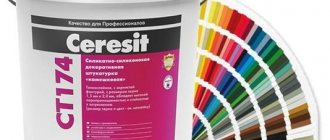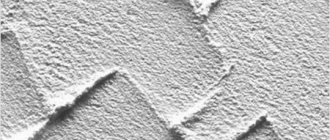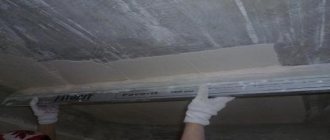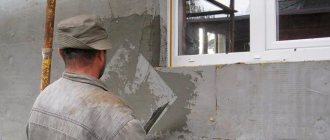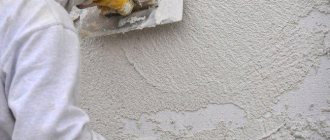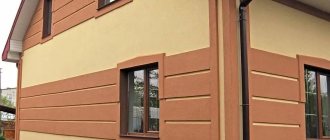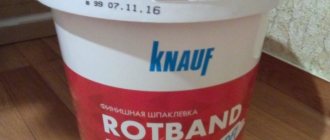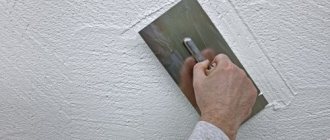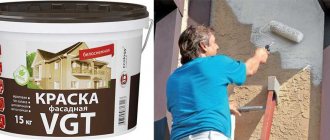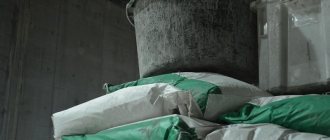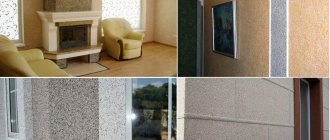For self-treatment of surfaces and preparation for applying a decorative layer, cement plasters for the facade are used. Using the composition in question, the base is leveled, dents, cracks are corrected, seams and other flaws are sealed. The contact layer enhances the adhesion of mating coatings, neutralizes the effects of temperature, and compensates for high humidity. The solution can be purchased ready-made or made independently.
Features of the mixture
The cement-based mixture is a well-deserved flagship among budget plasters. It guarantees a strong, fairly durable surface. The material is not afraid of moisture.
In addition to cement, the composition includes quarry sand, which provides the operational parameters of the finished mortar.
In order for the applied cement-based plaster intended for exterior use to look neat, the sand fraction must be the same. Very small particles cause the development of cracks in the coating, and large grains of sand interfere with the creation of a smooth surface.
In addition to the main ingredients, the composition of cement mortar for plastering external walls often includes additives that help improve the plasticity of the coating. Among them are polymer mixtures and copolymers. Thanks to their presence, such indicators as:
- strength;
- flexibility;
- elasticity;
- adhesion;
- wear resistance;
- resistance to frost.
Cement-sand mortar - characteristics and features
Cement-sand facade mixture leads the market for budget plasters due to its excellent strength and durability. The material is moisture-resistant, suitable for finishing the surfaces of facades of houses located in conditions of high humidity.
The basis of the mixture is cement marked from M150 to M 500. The numbers indicate the amount of pressure that the plaster can withstand with a volume of 1 cubic centimeter.
Most often, mixtures marked M 300 and higher are used for exterior work.
In addition to cement, the plaster contains quarry sand, which directly affects the performance characteristics of the solution. In addition to quarry sand, river sand can often act as a filler. Each manufacturer has its own proportions of using ingredients, which may vary depending on the characteristics of the latter.
In order for the plaster layer to be reliable and neat, it is important that the grains of sand included in the solution are the same size - medium. Too fine sand can lead to the formation of cracks in the coating, so solutions containing it are only suitable for finishing coating to achieve a “glossy” effect. Whereas large grains of sand will not leave the opportunity to form a truly flat surface, therefore they are suitable for rough exterior work.
In addition to the components listed above, plaster for facade work may contain additives to improve the plasticity of the material. These can be all kinds of polymer powders, as well as copolymers. Their inclusion in the composition makes it possible to improve the following qualities of the mixture:
- strength;
- elasticity;
- impact resistance;
- flexibility;
- adhesion;
- resistance to low temperatures;
- wear resistance.
It should also be noted that the right additives can improve the resistance of the plaster mixture to moisture. Cement-sand facade plaster has several subtypes and can be:
- simple;
- improved;
- elite.
Simple plaster for exterior use is applied in two layers and does not require installation of beacons or covering . The mixture is suitable for rough finishing in cases where the main goal is to level the surface and remove cracks and gouges.
Improved plaster for exterior use is applied in three layers, with the finishing coated with a special trowel . This type of plaster is one of the most popular, as it allows you to create a perfectly flat and smooth surface.
Elite plaster is applied over the beacons in five layers with a finishing coat for exterior work that requires the best quality.
Varieties
Cement-based facade plaster has two varieties:
- sandy;
- limestone.
The solutions differ in composition. For the first type I use only classic ingredients, and in the second, lime is added to them, which has an enhancing effect.
Cement-sand
Cement sand plaster is a budget option and has excellent durability and stability. Its basis is cement, the marking of which varies between M150–M500.
In addition to the main component, sand is also present. A simple mixture is used for rough finishing, wanting to level the surface. The improved type of coating is applied three times, grinding the finishing layer with a special grater. Elite mixtures are applied 5 times over the beacons, finishing with a covering to obtain ideal quality.
Cement-lime
When comparing cement facade plaster for exterior use, which contains an additive in the form of lime, with a conventional mixture, it should be understood that the former has improved strength characteristics. When preparing such a solution yourself, before using it, the lime must be quenched with water and then left for about a week. This event will protect the coating from blistering on the wall.
Do-it-yourself ready-made cement plaster for exterior use includes the following ingredients:
- sand;
- slaked lime;
- Portland cement;
- polypropylene fiber;
- additives that prevent moisture penetration.
It is better to apply the composition mechanically to a vertical surface.
The finished mixture is sold in dry form; you should prepare it yourself. The advantages of such a solution, optimal for application to facade walls, are as follows:
- versatility;
- high degree of adhesion;
- plastic;
- resistance to the formation of fungi and mold;
- wear resistance;
- long shelf life even after some time after preparation;
- the surface remains permeable to steam.
Flaws:
- low parameters for reducing compressive strength;
- costs more.
Cement-lime plaster
The cement-lime mixture is prepared on the basis of Portland cement, slaked lime and sand with a fraction of 1.25-2.5 mm. Can be applied manually or mechanically.
Used for initial leveling of surfaces of walls and ceilings of brick and concrete buildings. It can be used for repairs or reconstruction of old lime-cement plasters.
Advantages of cement-lime plaster:
- frost resistance;
- moisture resistance;
- strength;
- possibility of different application methods - manual and machine;
- can be used for painting.
Flaws:
- Short service life of the finished solution.
- Suitable for rough leveling of surfaces only. To give an aesthetic appearance, the application of decorative coatings will be required.
All dry construction mixtures are packaged in 25 kg bags. When storing, avoid exposure to moisture.
How to do it yourself?
The base of cement plaster consists of a binder and filler. The following materials serve as the latter:
- sand;
- lime;
- clay.
To prepare the solution, the dry mixture should be diluted with water until the required consistency is obtained. At home, the following proportions of components are used:
- cement with sand (1:3);
- PVA glue, which improves plasticity (50 ml per 10 l of solution).
To prepare a cement-lime composition, lime paste is added to the mixture. The recipe for its preparation is as follows:
- Place lime in a metal container and fill it with water in a ratio of 1:2;
- strain through a fine sieve, let the mixture stand for about two weeks;
- Dry substances or water are added to the solution to achieve the required consistency.
The need for separate preparation of lime dough is due to the fact that a lime-based solution has a short shelf life, unlike a sand mixture. Therefore, experts recommend mixing it only in the volume required for work.
Characteristics of ready-mixes for plastering products
It seems that there are no differences between the ready-made mixtures and the home-made version, although their composition is identical, it is dry cement, white sand and lime, but, in fact, this is not so. In any case, after all the work is completed, you will notice that the quality of purchased mixtures is much higher than the homemade version. The thing is that the sand in the prepared solutions is very clean and calibrated, plus it contains additional additives that increase the stickiness of the mixture.
Prices for ready-made mixtures vary widely. In Moscow, ready-made mixtures from the German manufacturer Knauf, which contain only good and high-quality impurities, are now very popular on the sales market. You can buy cement plaster almost ready for use; all you have to do is follow the instructions and add the required amount of water. One bag of dry mixture weighs 25 kilograms, which is quite a bit for the construction of small structures.
Application technology
There are several ways to apply plaster to vertical surfaces. They are divided into three classes, which have different technologies:
- Rough plaster is applied to the surface without beacons. Scope of application: outdoor work, when the appearance of the object is not important.
- High-quality plaster ensures uniform distribution of the layer. It requires subsequent grouting. The technique is appropriate where the coating is supposed to be additionally painted.
- Elite plaster. The principle of layer-by-layer application, when subsequent layers smooth out the flaws of previous coatings. For facades, this technique is rarely used due to its complexity.
Preparatory work
Any event requires preparation. The preliminary process consists of the following steps:
- cleaning walls;
- removal of old coatings and defects from the facade.
Do not leave areas on surfaces that can crumble under mechanical stress.
Splash
The first layer of the mixture is applied to the wall surface by pouring the solution with a special ladle. After this, the site must be leveled according to the rule, leaving no gaps. Leave the plaster to dry. This guarantees better adhesion of the previous layer to the next one. It is advisable to treat the surface with a layer of soil to protect it from fungus and mold. Using plaster and primer from the same manufacturer will prevent delamination and the coating will be truly complete.
Padding
The mixture for the second layer is thicker. The solution is applied with a spatula, and it is distributed over the surface to avoid unevenness after the initial coating.
The second layer is starting plaster, characterized by a coarse fraction. The surface turns out to be rough, but this will be compensated by the application of the next layer, which is leveling and finishing.
Covering
The correct choice of finishing plaster will add elegance to the facade. When using the “bark beetle” or “fleece” techniques, it is better to purchase compositions with a large fraction and small pebbles, which help create an original relief.
To obtain a smooth surface, use a material with a fine fraction.
The finishing layer is applied in the same way as the primer, only in this process the evenness of the coating is monitored more closely. After application, it is advisable to sand the surface additionally; you can also go over it with a metal grater.
Facade plaster consumption, prices
To first understand the consumption and price of facade plaster per 1 m2, the cost of plastering work and your financial capabilities, and then control the use of finishing plaster by third-party specialists, you can use the calculator button on the pages of our hardware store website to “calculate the consumption” of the required material.
You can buy external plaster in our hardware store wholesale or retail. Using wholesale purchases, financial costs are greatly reduced, and uninterrupted work on plastering the object is ensured.
Pros and cons of coverage
Cement facade plaster has a number of positive qualities. The main ones include:
- low cost of material;
- high coefficient of vapor permeability;
- simple application technique that does not require expensive equipment;
- the ability to use a dye that allows you to obtain a variety of shades;
- high strength;
- durability;
- high rates of heat and sound insulation characteristics.
Disadvantages of the material:
- Short lifespan of the finished mixture. When the plaster is diluted with water and is ready for use, it can be used for no more than 2 hours.
- It is recommended to apply the coating only under certain climatic conditions. The optimal temperature is from 10 to 25° C.
- A finishing coat is required. Since plaster absorbs moisture well, it can become very damp when it rains. When it gets colder sharply after this, the coating will certainly crack. Only paint guarantees a moisture-proof film that will reliably protect the facade.
Disadvantages of cement plaster
There are few of them, but they still exist.
- Short viability of the finished mixture. After the mixture is diluted with water and prepared for use, it hardens within 1-2 hours. If you do not have time to use it up during this time, then the solution becomes unsuitable for work.
- Temperature limits for use. Work using facade cement plaster is carried out only at positive air temperatures, in the range of 5-30 degrees. You cannot work with them in hot or cold weather.
- Required topcoat. Facade cement plaster requires additional treatment with special finishing putties or gluing with tiles.
- Price. Current prices for mixtures of this level are not inexpensive.

